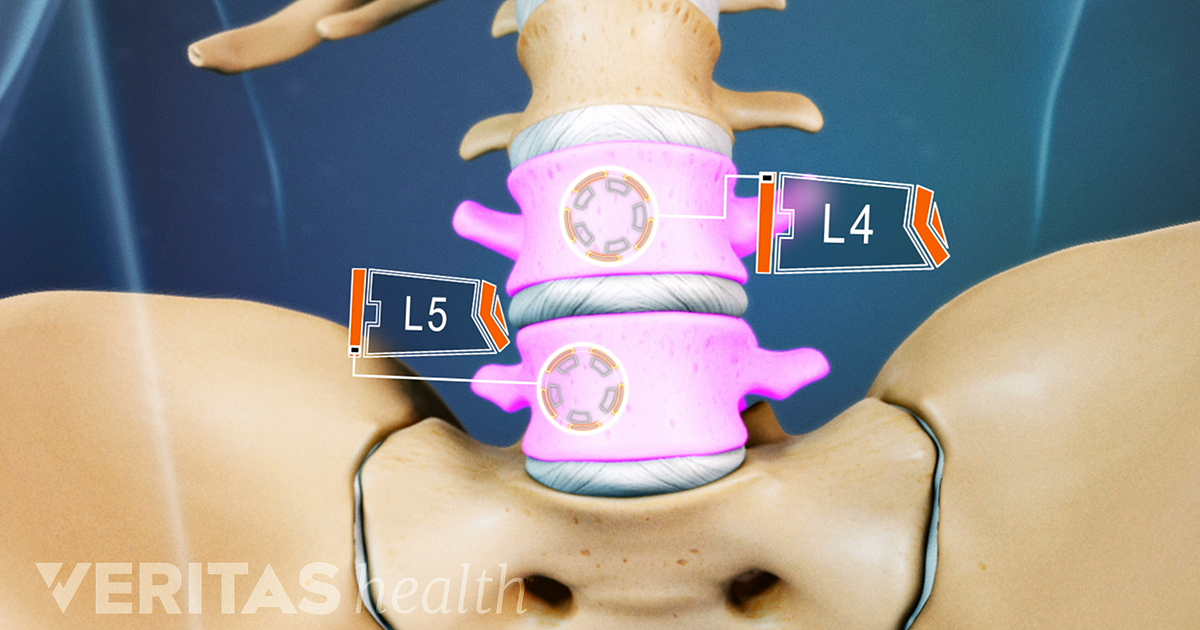Back surgery for L4-L5 refers to spinal fusion at the lumbar region of the spine. It is a procedure that involves removing part of the vertebral bone, disc, or both to eliminate pressure on the nerves and provide pain relief. Spinal fusion is typically performed when other treatments such as exercise or physical therapy don’t provide adequate relief.END Q: What are some common reasons for L4-L5 back surgery? A: Common reasons for undergoing back surgery at this level include degenerative disc disease, spondylolisthesis, sciatica, and herniated discs.END Q: What types of techniques may be used? A: Fusion techniques vary depending on the health of your bones and the type of incision that's being made. Commonly used techniques include open posterior lumbar interbody fusion (PLIF), anterior lumbar interbody fusion (ALIF), transforaminal lumbar interbody fusion (TLIF), and lateral lumbar interbody fusion (LLIF).END Q: Are there any risks associated with this type of surgery? A: As with any surgical procedure, there are potential risks associated with L4-L5 back surgery. These include infection, nerve damage, blood clots, bone graft failure or nonunion, implant failure, dural tear, increased pain postoperatively and other complications specific to the technique used.END Q: How long does recovery take after the procedure? A: Recovery time depends on various factors such as age, medical conditions and lifestyle habits prior to surgery. Generally speaking most surgeries require 4 to 6 weeks of recovery time before you can return to full activities again.END Q: How do I know if I am a good candidate for this type of back surgery? A: Your doctor will consider your medical history and condition when deciding whether you are a good candidate for L4-L5 back surgery. Your doctor may suggest you try other treatments before proceeding with Surgery if possible.END Conclusion: Back surgery at the L4-L5 level can help reduce pain caused by different conditions including degenerative disc disease and herniated discs. Although it has risks associated with it just like any other surgical procedure it can also bring much needed relief from chronic pain in many cases when all noninvasive treatments have failed to yield desirable results. If you are considering having this type of surgery talk to your physician about whether it’s an option for you and what steps you need to take in order for it to be successful.

Table Of Content:
- L4-L5 Treatment
- Back Surgery: Types, Recovery, Risks, and Benefits
- All About the L4-L5 Spinal Segment
- Back surgery: When is it a good idea? - Mayo Clinic
- Lumbar Spinal Fusion Surgery
- When Back Surgery Is the Last Resort, But the Best Solution | NYU ...
- Lumbar decompression surgery - How it's performed - NHS
- Minimally Invasive Lumbar Discectomy | Johns Hopkins Medicine
- Lumbar decompression surgery - NHS
- Minimally Invasive Spine Surgery – How Does It Work?
1. L4-L5 Treatment
https://www.spine-health.com/conditions/spine-anatomy/l4-l5-treatment Treatment of the L4-L5 spinal motion segment typically begins with nonsurgical methods. In cases where the back and/or leg symptoms do not improve with ...
Treatment of the L4-L5 spinal motion segment typically begins with nonsurgical methods. In cases where the back and/or leg symptoms do not improve with ...
2. Back Surgery: Types, Recovery, Risks, and Benefits
https://www.webmd.com/back-pain/back-surgery-types Laminectomy. This is the most common surgery for lumbar spinal stenosis. In this procedure, a surgeon removes parts of the bone, bone spurs, or ligaments in ...
Laminectomy. This is the most common surgery for lumbar spinal stenosis. In this procedure, a surgeon removes parts of the bone, bone spurs, or ligaments in ...
3. All About the L4-L5 Spinal Segment
https://www.spine-health.com/conditions/spine-anatomy/all-about-l4-l5-spinal-segment The L4 and L5 are the two lowest vertebrae of the lumbar spine. Together with the intervertebral disc, joints, nerves, and soft tissues, the L4-L5 spinal ...
The L4 and L5 are the two lowest vertebrae of the lumbar spine. Together with the intervertebral disc, joints, nerves, and soft tissues, the L4-L5 spinal ...
4. Back surgery: When is it a good idea? - Mayo Clinic
https://www.mayoclinic.org/diseases-conditions/back-pain/in-depth/back-surgery/art-20048274 Back pain rarely requires surgery. Research your options before going under the knife.
Back pain rarely requires surgery. Research your options before going under the knife.
5. Lumbar Spinal Fusion Surgery
https://www.spine-health.com/treatment/spinal-fusion/lumbar-spinal-fusion-surgery Two vertebral segments need to be fused together to stop the motion at one segment, so that an L4-L5 (lumbar segment 4 and lumbar segment 5) spinal fusion is ...
Two vertebral segments need to be fused together to stop the motion at one segment, so that an L4-L5 (lumbar segment 4 and lumbar segment 5) spinal fusion is ...
6. When Back Surgery Is the Last Resort, But the Best Solution | NYU ...
https://nyulangone.org/news/when-back-surgery-last-resort-best-solution “It was an extremely large herniation of the L4–L5 disc, the one most commonly injured,” explains Dr. Anderer. The success rate for disc surgery is about 90 ...
“It was an extremely large herniation of the L4–L5 disc, the one most commonly injured,” explains Dr. Anderer. The success rate for disc surgery is about 90 ...
7. Lumbar decompression surgery - How it's performed - NHS
https://www.nhs.uk/conditions/lumbar-decompression-surgery/what-happens/ The surgeon makes an incision (cut) over the affected section of spine down to the lamina (bony arch of your vertebra), to access the compressed nerve. The ...
The surgeon makes an incision (cut) over the affected section of spine down to the lamina (bony arch of your vertebra), to access the compressed nerve. The ...
8. Minimally Invasive Lumbar Discectomy | Johns Hopkins Medicine
https://www.hopkinsmedicine.org/health/treatment-tests-and-therapies/minimally-invasive-lumbar-discectomy
9. Lumbar decompression surgery - NHS
https://www.nhs.uk/conditions/lumbar-decompression-surgery/ Lumbar decompression surgery is a type of surgery used to treat compressed nerves in the lower (lumbar) spine. It's only recommended when non-surgical ...
Lumbar decompression surgery is a type of surgery used to treat compressed nerves in the lower (lumbar) spine. It's only recommended when non-surgical ...
10. Minimally Invasive Spine Surgery – How Does It Work?
https://www.aans.org/Patients/Neurosurgical-Conditions-and-Treatments/Minimally-Invasive-Spine-Surgery Conditions Treated Using MIS Procedures · Degenerative disc disease · Herniated disc · Lumbar spinal stenosis · Spinal deformities such as scoliosis · Spinal ...
Conditions Treated Using MIS Procedures · Degenerative disc disease · Herniated disc · Lumbar spinal stenosis · Spinal deformities such as scoliosis · Spinal ...
What are some common reasons for L4-L5 back surgery? A: Common reasons for undergoing back surgery at this level include degenerative disc disease, spondylolisthesis, sciatica, and herniated discs.END Q: What types of techniques may be used? A: Fusion techniques vary depending on the health of your bones and the type of incision that's being made. Commonly used techniques include open posterior lumbar interbody fusion (PLIF), anterior lumbar interbody fusion (ALIF), transforaminal lumbar interbody fusion (TLIF), and lateral lumbar interbody fusion (LLIF).END Q: Are there any risks associated with this type of surgery? A: As with any surgical procedure, there are potential risks associated with L4-L5 back surgery. These include infection, nerve damage, blood clots, bone graft failure or nonunion, implant failure, dural tear, increased pain postoperatively and other complications specific to the technique used.END Q: How long does recovery take after the procedure? A: Recovery time depends on various factors such as age, medical conditions and lifestyle habits prior to surgery. Generally speaking most surgeries require 4 to 6 weeks of recovery time before you can return to full activities again.END Q: How do I know if I am a good candidate for this type of back surgery?
Common reasons for undergoing back surgery at this level include degenerative disc disease, spondylolisthesis, sciatica, and herniated discs.END Q: What types of techniques may be used? A: Fusion techniques vary depending on the health of your bones and the type of incision that's being made. Commonly used techniques include open posterior lumbar interbody fusion (PLIF), anterior lumbar interbody fusion (ALIF), transforaminal lumbar interbody fusion (TLIF), and lateral lumbar interbody fusion (LLIF).END Q: Are there any risks associated with this type of surgery? A: As with any surgical procedure, there are potential risks associated with L4-L5 back surgery. These include infection, nerve damage, blood clots, bone graft failure or nonunion, implant failure, dural tear, increased pain postoperatively and other complications specific to the technique used.END Q: How long does recovery take after the procedure? A: Recovery time depends on various factors such as age, medical conditions and lifestyle habits prior to surgery. Generally speaking most surgeries require 4 to 6 weeks of recovery time before you can return to full activities again.END Q: How do I know if I am a good candidate for this type of back surgery? A: Your doctor will consider your medical history and condition when deciding whether you are a good candidate for L4-L5 back surgery. Your doctor may suggest you try other treatments before proceeding with Surgery if possible.END Conclusion: Back surgery at the L4-L5 level can help reduce pain caused by different conditions including degenerative disc disease and herniated discs. Although it has risks associated with it just like any other surgical procedure it can also bring much needed relief from chronic pain in many cases when all noninvasive treatments have failed to yield desirable results. If you are considering having this type of surgery talk to your physician about whether it’s an option for you and what steps you need to take in order for it to be successful.
Conclusion:
Back surgery at the L4-L5 level can help reduce pain caused by different conditions including degenerative disc disease and herniated discs. Although it has risks associated with it just like any other surgical procedure it can also bring much needed relief from chronic pain in many cases when all noninvasive treatments have failed to yield desirable results. If you are considering having this type of surgery talk to your physician about whether it’s an option for you and what steps you need to take in order for it to be successful.
